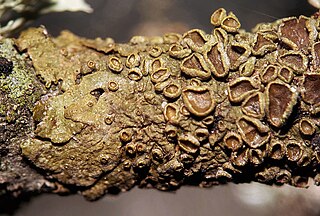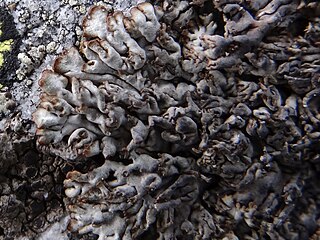
The Parmeliaceae is a large and diverse family of Lecanoromycetes. With over 2700 species in 71 genera, it is the largest family of lichen-forming fungi. The most speciose genera in the family are the well-known groups: Xanthoparmelia, Usnea, Parmotrema, and Hypotrachyna.

Melanohalea is a genus of foliose lichens in the family Parmeliaceae. It contains 30 mostly Northern Hemisphere species that grow on bark or on wood. The genus is characterised by the presence of pseudocyphellae, usually on warts or on the tips of isidia, a non-pored epicortex and a medulla containing depsidones or lacking secondary metabolites. Melanohalea was circumscribed in 2004 as a segregate of the morphologically similar genus Melanelia, which was created in 1978 for certain brown Parmelia species. The methods used to estimate the evolutionary history of Melanohalea suggest that its diversification primarily occurred during the Miocene and Pliocene epochs.

Parmotrema is a genus of lichen belonging to the family Parmeliaceae. It is a large genus, containing an estimated 300 species, with a centre of diversity in subtropical regions of South America and the Pacific Islands.

Allantoparmelia is a genus of lichenised fungi in the large family Parmeliaceae. It is a genus of only three currently accepted species. All three Allantoparmelia lichens have a foliose growth form. They appear to be a very slow growing group of lichens, with a mean annual thallus diameter increase of only 0.23–0.35 mm per year.

Esslingeriana is a fungal genus in the family Parmeliaceae. The genus is monotypic, containing the single foliose lichen species Esslingeriana idahoensis, commonly known as the tinted rag lichen. It is found in northwestern North America.
Emodomelanelia is a lichen genus in the family Parmeliaceae. It is monotypic, containing the single foliose Himalayan species Emodomelanelia masonii.
Austromelanelixia is a genus of five species of foliose lichens in the family Parmeliaceae. All species are found in the Southern Hemisphere.
Melanohalea zopheroa is a species of lichen in the family Parmeliaceae. It was first formally described in 1977 by Ted Esslinger as Parmelia zopheroa. A year later, he transferred it to the new genus Melanelia, which he created to contain the brown Parmeliae species. In 2004, after early molecular phylogenetic evidence showed that Melanelia was not monophyletic, Melanohalea was circumscribed by lichenologists Oscar Blanco, Ana Crespo, Pradeep K. Divakar, Esslinger, David L. Hawksworth and H. Thorsten Lumbsch, and M. zopheroa was transferred to it. The lichen has a disjunct distribution, as it is found in South America (Chile) and in New Zealand.
Melanohalea ushuaiensis is a species of lichen in the family Parmeliaceae. It was first formally described in 1917 by Alexander Zahlbruckner as Parmelia ushuaiensis. Ted Esslinger transferred to the new genus Melanelia in 1978, which he circumscribed to contain the brown parmeliae species. In 2004, it was moved to the newly created genus Melanohalea. It is endemic to South America.
Melanohalea trabeculata is a species of foliose lichen in the family Parmeliaceae. It was first formally described by Finnish lichenologist Teuvo Ahti in 1966 as Parmelia trabeculata. Ted Esslinger transferred the species to the new genus Melanelia in 1978, which he circumscribed to contain the brown parmeliae species. In 2004, it was moved to the newly circumscribed genus Melanohalea.
Melanohalea subverruculifera is a species of lichen in the family Parmeliaceae. Found in China, it was first formally described as a new species in 1980 as Parmelia subverruculifera. It was transferred to the segregate genus Melanelia in 1991, and then to the genus Melanohalea in 2004.

Melanohalea subolivacea, commonly known as the brown-eyed camouflage lichen, is a species of foliose lichen in the family Parmeliaceae.

Melanohalea subelegantula is a species of lichen in the family Parmeliaceae. It is found in North America, where it grows on bark and wood. The lichen was first formally described as Parmelia subelegantula by Ted Esslinger in 1977. A year later he transferred it to the segregate genus Melanelia. In 2004, it was moved to the newly circumscribed genus Melanohalea. Named for its resemblance to Melanohalea elegantula, it can be distinguished from that species by its slightly flattened, but not hollow, isidia.

Melanohalea elegantula, commonly known as the elegant camouflage lichen, is a species of lichen in the family Parmeliaceae. It was first described by Alexander Zahlbruckner in 1894 as Parmelia aspidota var. elegantula. Hungarian lichenologist Ödön Szatala promoted it to full species status, as Parmelia elegantula, in 1930. Ted Esslinger transferred it to the genus Melanelia in 1978. Finally, it was assigned to the newly circumscribed genus Melanohalea in 2004.

Montanelia is a genus of lichenized fungi belonging to the family Parmeliaceae. It was circumscribed by Pradeep K. Divakar, Ana Crespo, Mats Wedin, and Theodore L. Esslinger in 2012 to accommodate a group of five species previously assigned to the genus Melanelia.
Melanelixia ahtii is a species of foliose lichen in the family Parmeliaceae. Found in the United States, it was formally described as a new species in 2016 by Theodore Lee Esslinger, Ana Crespo, Helge Thorsten Lumbsch, Pradeep Kumar Divakar, and Steven Leavitt. The type specimen was collected from the north side of the Columbia River Gorge. Here, at an elevation of 75 m (246 ft) above sea level, it was found in a mixed oak-ponderosa pine forest, growing as an epiphyte on an oak. The species is known from DNA-verified collections in four western US states: California, Idaho, Oregon, and Washington. The species epithet ahtii honours Finnish lichenologist Teuvo Ahti, "for his contributions to understanding diversity in brown parmelioid lichens".

Melanelixia albertana is a species of corticolous (bark-dwelling), foliose lichen in the family Parmeliaceae. First described in 1969 from collections made in Alberta, Canada, it has undergone two taxonomic reclassifications before ultimately being placed in the genus Melanelixia in 2004. The species is characterised by the soralia on the margins of its lobes, a feature that is rare in brown parmelioid lichens. This feature is reflected in its common name, powder-rimmed camouflage lichen. Melanelixia albertana has an unusual Asian-North American disjunct distribution. The widespread presence of Melanelixia albertana across different regions is attributed to the similar climatic and vegetative conditions found in the northern parts of the interior prairies in North America, as well as in the forest steppe and ultracontinental taiga forests of northern Mongolia, Transbaikal, and Yakutia. It occurs in river valley and ravine systems, as well as aspen parkland.

Melanelia hepatizon, commonly known as the rimmed camouflage lichen or the rimmed brown-shield, is a species of saxicolous (rock-dwelling), foliose lichen in the family Parmeliaceae. Its thallus, ranging in colour from brown to black, features narrow, elongated lobes that can be flat, convex, or concave. This lichen has a circumpolar distribution, occurring in Asia, Europe, North America, Iceland, and Greenland.

Melanohalea exasperatula, commonly known as the lustrous camouflage lichen or lustrous brown-shield, is a species of corticolous (bark-dwelling) foliose lichen in the family Parmeliaceae. It has a widespread global distribution and is common in both Europe and northern North America. Its thallus can grow up to 5 cm (2 in) in diameter, with marginal lobes up to 5 mm broad. The upper surface is pale olive-green to red-brown, with isidia that are unbranched, inflated, and hollow. It can be distinguished from similar species by the shape and structure of these isidia. The lower surface of the thallus is pale tan to pale brown with scattered, pale rhizines. Apothecia are uncommon, while pycnidia and secondary metabolites have not been observed in this species. The lack of defensive chemicals makes it vulnerable to grazing by slugs and snails. The evolutionary history of Melanohalea exasperatula is linked to major climatic events during the Miocene and Pliocene epochs.

Melanelixia californica, the California camouflage lichen, is a species of foliose lichen in the family Parmeliaceae. It was first described in 2010 after molecular studies revealed that what was thought to be the European species Melanelixia glabra in North America was actually a distinct species. The lichen forms olive-green, leaf-like growths up to 6 cm (2.4 in) across and is characterized by its sparse transparent surface hairs and disk-shaped fruiting bodies. It is found primarily in southern California, where it grows mainly on oak trees in Mediterranean climate zones at elevations ranging from 640–1,700 m (2,100–5,580 ft), though it has also been reported from Oregon's Cascade–Siskiyou National Monument.














